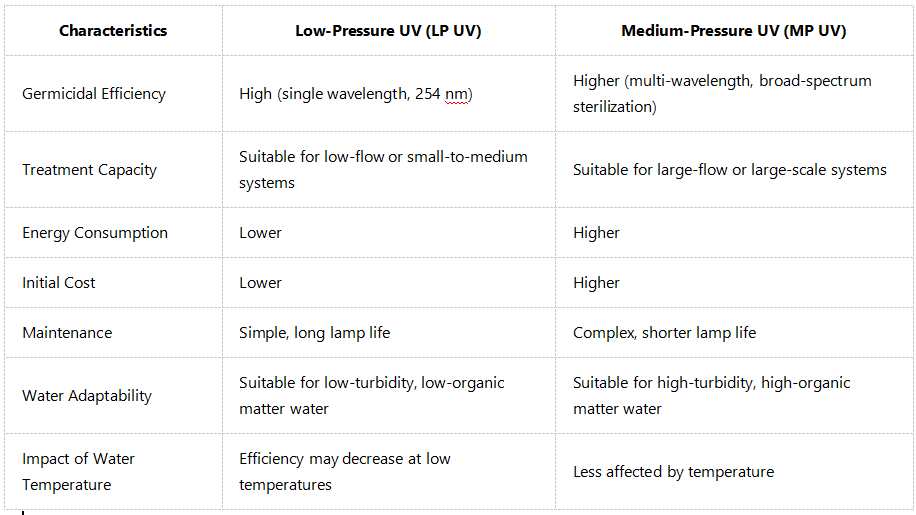Classification and Functions of Ultraviolet Sterilizers in Recirculating Aquaculture Systems
Recirculating Aquaculture Disinfection System
In recirculating aquaculture systems, the hazards of bacteria and viruses cannot be underestimated. Bacteria consume a large amount of dissolved oxygen in water, leading to oxygen deficiency in farmed organisms, slow growth, and even death. Pathogenic bacteria such as Flavobacterium columnare and Aeromonas hydrophila can cause diseases like gill rot and septicemia in farmed organisms, leading to large-scale mortality and significant economic losses for aquaculturists. Viral infections are characterized by fast transmission and difficulty in control, which can infect a large number of farmed individuals in a short time, disrupt their physiological functions, and severely impact aquaculture efficiency.
Ultraviolet (UV) and ozone are highly effective in killing bacteria and viruses. UV radiation penetrates the cell membrane of microorganisms through strong radiative light waves, reaches the nucleus, and breaks the DNA double helix structure, preventing bacteria from reproducing and leading to their death. It is particularly effective against suspended bacterial microorganisms in water. Ozone, with strong oxidizing properties, reacts rapidly with bacteria and viruses, destroying their organelles, DNA, and RNA, and altering cell permeability, leading to cell lysis and death. It can kill a variety of microorganisms, including bacterial vegetative cells, spores, viruses, and fungi. Due to its good diffusibility, ozone can disinfect the entire aquaculture water without dead angles.
UV Sterilization
1. Classification by Installation Method
UV sterilization lamps can be classified into two types based on installation method: pipe-mounted and channel-mounted:
1. Pipe-mounted UV sterilization lamps are usually installed inside the water delivery pipelines of recirculating aquaculture systems. Water flows directly through the pipe section with the sterilization lamp, ensuring full contact between water and UV light, thus efficiently sterilizing the flowing water. Their advantages include a compact structure that integrates well with the pipeline system, making them suitable for water sterilization in scenarios with relatively low flow rates.
2. Channel-mounted UV sterilization lamps are generally installed above or on the sides of open water channels with a certain width and depth, irradiating and sterilizing the water flowing through the channel. They can cover a large area of water, making them suitable for handling large flow rates and open water bodies, ensuring that a large area of water is effectively irradiated by UV light to guarantee sterilization performance.
2. Classification by Voltage Intensity
UV sterilization lamps are divided into two types based on voltage intensity: low-pressure and medium-pressure:
Low-pressure (LP) UV sterilization lamps operate at relatively low voltages and typically generate single-wavelength UV light, mostly around 254 nanometers. This wavelength has a significant germicidal effect, low energy consumption, and good stability. However, their power is relatively limited, making them suitable for small-scale applications or places where extremely high sterilization intensity is not required.
Medium-pressure (MP) UV sterilization lamps operate at higher voltages, generating multi-wavelength UV light with a wider coverage and stronger germicidal capability. They have higher power, allowing rapid treatment of large-flow and highly polluted water bodies. However, they consume more energy and have higher equipment costs, making them commonly used in large-scale recirculating aquaculture systems with high requirements for sterilization efficiency and treatment capacity.

3. Principles and Influencing Factors of UV Sterilization
UV light is a type of electromagnetic radiation, divided into multiple wavelength bands. The primary band used for sterilization is the UVC band (200-280 nanometers), with around 254 nanometers being the most effective wavelength for germicidal purposes. When recirculating water carrying microorganisms such as bacteria flows through the irradiation area of a UV sterilization lamp, the energy of UV photons is absorbed by the genetic material (such as DNA or RNA) inside the microbial cells. The chemical bonds in these genetic materials break after absorbing sufficient UV energy—for example, hydrogen bonds in the DNA double helix structure are destroyed—thereby disrupting genetic information processes such as replication and transcription. This prevents microorganisms like bacteria from reproducing, leading to their death and thus sterilizing and purifying the recirculating water, ensuring water quality safety and creating a healthy growth environment for farmed organisms.
The main factors influencing the effectiveness of UV sterilization in recirculating aquaculture are as follows:
1.UV Dosage
UV dosage, determined by UV intensity and irradiation time, is critical for sterilization effectiveness. Insufficient dosage cannot break the DNA or RNA structure of microorganisms like bacteria and viruses, leading to ineffective sterilization. Only when the specific dosage required by the target microorganisms is achieved can a good sterilization rate be ensured.
2.Water Turbidity
Suspended solids and organic particles in water increase turbidity. These impurities scatter and absorb UV light, preventing it from penetrating the water and reducing the actual UV exposure of microorganisms, thus decreasing sterilization efficiency. The higher the turbidity, the more UV light is attenuated, and the poorer the sterilization capability.
1. Water Flow Rate
Too fast a water flow rate shortens the residence time of microorganisms in the UV irradiation area, preventing them from receiving sufficient UV dosage and leading to incomplete sterilization. Too slow a flow rate, while ensuring irradiation time, may affect the overall efficiency of the recirculating water system.
2. Microbial Species
Different microorganisms have varying tolerances to UV light. For example, bacterial spores, due to their special structure, are more resistant to UV irradiation than ordinary bacterial cells. Viruses, lacking a cellular structure, also differ in their UV sensitivity from bacteria. Therefore, the types of microorganisms present affect sterilization efficacy.
3. Lamp Aging Degree
As usage time increases, the luminous efficiency of UV lamps gradually decreases, reducing the output UV intensity and the effective sterilization dosage provided. This leads to a decline in sterilization performance compared to when the lamps were newly installed.

Tel.: +86 17864390557





